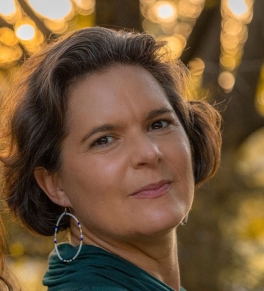For Katy Backes Kozhimannil, water is intrinsically tied to her life’s work. As a professor of public health at the University of Minnesota with a focus on rural communities, she has made it her life purpose to be “a guardian, a protector of life cycles.” As an Ojibwe woman, she sees water as the ultimate life giver.
“For me, there's a parallel between life cycles of humans and our non-human relatives and the cycles of water and how we work together to protect one another,” she said.

As the co-director of the University's Rural Health Research Center, Katy knows there are deep roots between water and rural communities in Minnesota. As she sees it, “the effect of climate change as experienced through water is the biggest threat to public health in greater Minnesota and in the metro area. I think it will be and is first felt in more rural areas and communities.”
Through her job, she is an advocate for these communities and is especially mindful of the ways that water affects them. But Katy’s connection to and protection of water runs deeper than her day-to-day job. It is part of her calling, she said.
“I feel I owe that water — that lake, that land, that space — I owe that water my attention, my voice,” she said. “Because water cannot speak in a way that policymakers understand. So it is a reciprocal relationship. If I value and honor that water — that always accepts me, that I can go to again and again, that is never too tired to hold me or to lift me up — then I need to remember to have that same stance toward the water, toward our lakes: to hold them and to lift them up and to speak for them and use the voice that I have to speak on behalf of the water.”
Visit We Are Water MN to learn more
Katy shared her story as a part of We Are Water MN, a traveling exhibit and community engagement initiative that explores Minnesotans’ relationship with water. The Minnesota Valley National Wildlife Refuge will host the exhibit through Feb. 1, 2026.
The Minnesota Valley National Wildlife Refuge is located in the Lower Minnesota River Watershed. Stretching across south-central Minnesota, the Lower Minnesota River Watershed is home to 2,432 miles of streams and 133 lakes. Its western half is dominated by row crop agriculture while its eastern half is marked by urban development. The Minnesota River itself runs northeast from Le Sueur to Bloomington, eventually flowing into the Mississippi River at Bdote — a Dakota word meaning confluence, the place where two waters come together — near Fort Snelling in Saint Paul.
Visit the exhibit to hear local stories and learn more about water in this region.
- dates: Nov. 22, 2025 – Feb. 1, 2026
- hours: Wednesday-Sunday, 10 a.m. to 5 p.m. (closed federal holidays)
- location: Bloomington Education and Visitor Center (3815 American Blvd. E, Bloomington, MN 55425)
About We Are Water MN
We are Water MN is a project of the Minnesota Pollution Control Agency and the Minnesota Humanities Center in partnership with the Minnesota Historical Society; the Board of Water and Soil Resources; the Minnesota Departments of Agriculture, Health, and Natural Resources; and University of Minnesota Extension.
The program is funded by the Clean Water Fund, part of the Clean Water, Land & Legacy Amendment, which was created with the vote of the people of Minnesota on Nov. 4, 2008.
